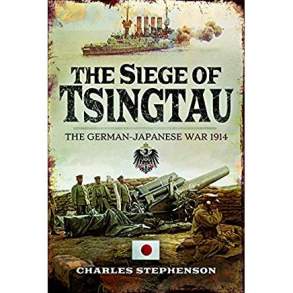Review – The Siege of Tsingtau

Four Stars
The Siege of Tsingtau is a professional read. Stephenson threads the narrative with insightful analysis and precise detail that oftentimes are primarily apt for the military historian. Nonetheless, he develops with absolute clarity this little known, yet critically important, battle of World War One with long-range repercussions on the Pacific War of the 1940s.
In the early twentieth century, the Empire of Japan had no pressing quarrel with Imperial Germany. As World War One erupted in Europe, the Middle East, and Africa, the quasi-military government of the Land of the Rising Sun seized a golden opportunity and on 14 August 1914 declared war on Deutschland. Japan’s goals were twofold: to counter Germany’s imperialist expansion in the Orient and to capture Germany’s vast central-Pacific empire stretching some 2,300 nautical miles across the ocean. Included were the Caroline Islands, Marshalls, Marianas, Pelews, Maloelap, and others—an area that encompassed all of Micronesia.
Within 86 days, the Imperial Japanese Army had captured Imperial Germany’s Oriental possessions and Pacific Ocean colonies, including the leased German Kiautschou Protectorate on China’s Shantung peninsula and its port city Tsingtau. The Japanese conducted their siege campaign thoroughly, professionally, and, most importantly, effectively. In fairness, the German defenders were naval infantry personnel who were outnumbered in personnel and overwhelmed in equipment and training.
The German East Asiatic Naval Squadron, which consisted of two armored cruisers, the SMS Scharnhorst and the SMS Gneisenau, and four light cruisers, escaped the Japanese naval blockade and steamed toward Germany’s colonies in Micronesia. An Imperial Japanese Navy task force, led by the battle cruiser IJN Shikshim, pursued the escaping German squadron with the ostensible goal of destroying it, thus ensuring safe passage for Allied commerce in the central Pacific.
However, when the Imperial Japanese Navy reached Germany’s Pacific Ocean possessions in the central and southern Pacific, they abandoned the pursuit and let the German squadron sail eastward towards Frederikshavn, their home port.
Japan’s victory secured and expanded its existing political and economic position in the Orient. More importantly, Japan took possession of German Micronesia and established a “Bamboo Curtain” that flanked any line of communication across the central Pacific and prevented passage through the area, all in violation of Japan’s League of Nations mandate. Shortly, the Japanese Imperial Navy began the fortification of key islands, the preliminary phase of their planned Pacific War with the Occidental colonial powers. Such bases included Saipan in the Marianas, Truk, Ponape and the Palau Islands in the Carolines, and Kwajalein, Wotje, and Jaluit in the Marshall—names all too familiar to our Greatest Generation.
FIN
Read more by S. Martin Shelton!
Every major episode in our histories is always the result of the past. I lay odds that very few knew about this connection!
Thanks for your comments.
Marty